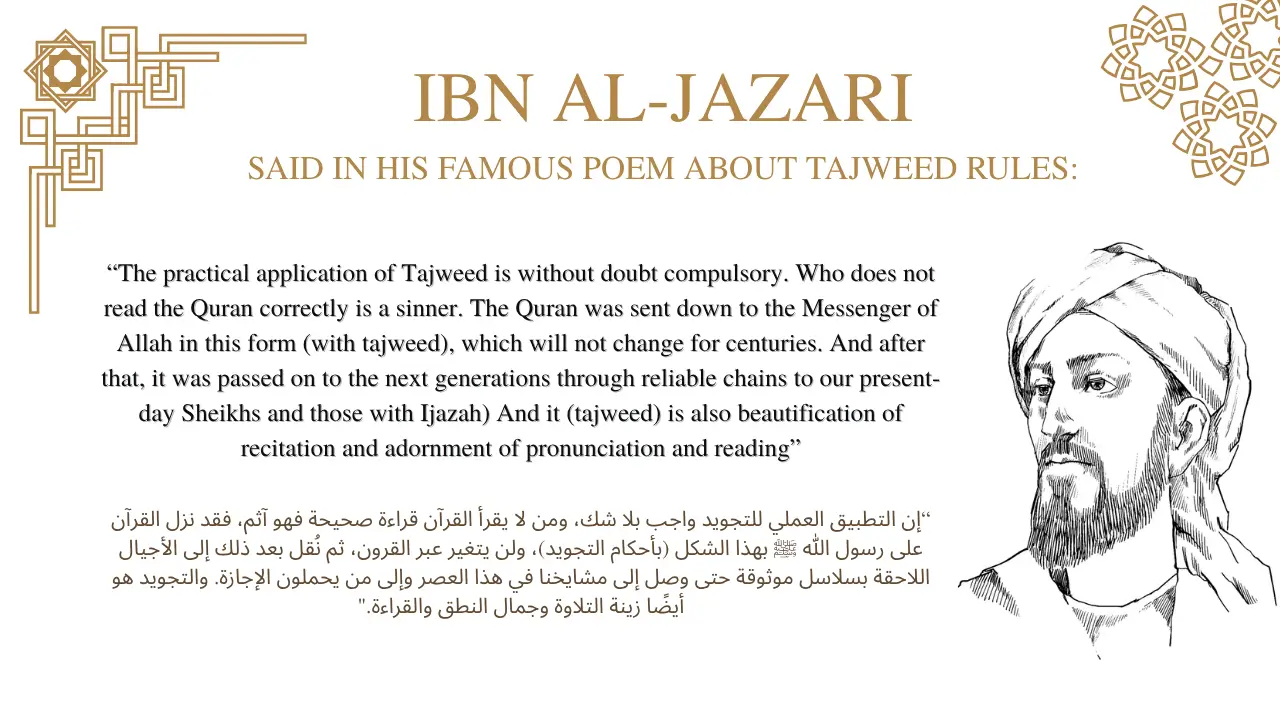The dearest remembrance to Allah is the recitation of the Quran. Allah says: (وَرَتِّلِ الْقُرْآنَ تَرْتِيلً) “…and recite the Qur’an clearly with tartil” (Surah Al-Muzzammil 73:4). To recite the Quran properly as it was revealed to our Prophet Mohamed (PBUH), you must be aware of the Tajweed rules. Here we are, today we clarify the rules of noon sakinah and tanween in a simplified way with examples to improve your grasp of it, in addition to a practical task to check your comprehension.
What Are Noon Sakinah and Tanween?
Before diving into the rules of Noon Sakinah and Tanween, let’s learn first the meaning of Noon Sakinah and Tanween. They share a common sound of /n/.
Noon sakinah Meaning
Noon sakinah is the letter Noon (ن) with a Sukoon on it, which means it’s free from any Harakat (Fattaha, Damma, and Kassra). Therefore, a Noon should be sakinah to apply the following rules.
Examples: أَنۡعَمۡتَ/ مِن مَّالٍ/ مِنۢ بَعۡدِ
Tanween Meaning
Tanween is the change that occurs in the word that is called “nunation”. Adding an “n” sound to the end of a word in certain cases. So, if we have the word (كتاب) that is pronounced like /kitaab/ when we add Tanween to it (كتابٍ) its pronunciation will be /kitaabn/ due to the Tanween effect.
Examples: كُفُوًا / سَمِيعٌ / شَيْءٍ
In writing, Tanween refers to the two-dot diacritics placed above or under a letter, changing its sound to noon. Its forms are:
- Tanween Fathah (ً): بابًا
- Tanween Dhammah (ٌ): بابٌ
- Tanween Kasrah (ٍ): بابٍ
Rules of Noon Sakinah and Tanween

Rules of Noon sakinah and Tanween are mainly divided into four categories. Depending on the following letter, you can determine which rule you must apply.
1. Izhar (Clear Pronunciation)
This word “Izhar” means making something clear. By seeing one of the throat letters, which are called “Huroof Halaqiyya” after Noon Sakinah or Tanween, you must pronounce the Noon or Tanween clearly. Doesn’t take effort, right? Let’s see the letters of Izhar:
| Letters | Examples |
|---|---|
| ء – هـ – ع – ح – غ – خ | وَعِلْمًا حَسَنًا / مِنْ غِلٍّ |
2. Idgham (Merging)
It’s merging a Noon or Tanween with the following letter (ي ر م ل و ن ), coupled with Ghunna or without. It’s divided into two types:
- Idghaam with Ghunna: It occurs with the letters (ي – م – ن – و). So, you should produce Ghunna (nasal sound) for 2 counts.
- Idghaam without Ghunna: It occurs with the letters (ل – ر). So, you merge the Noon or Tanween with the following letter without Ghunna. It is passed quickly, unlike the first type.
| Idgham Letters | Examples |
|---|---|
| ي ر م ل و ن | مِنْ يَسْمَع / صُحُفًا مُطَهَّرَةً |
3. Iqlab (Substitution)
Iqlab is the easiest rule of them as it happens with only one letter, which is r Baa (ب). If there is a Baa after a Noon Saakin or Tanween, we must apply the rule of Iqlaab by converting the sound of a Noon Saakin or Tanween into a Meem, stretching it to add Ghunna.
| Idgham Letters | Examples |
|---|---|
| ( ب ) | أن بورك / زوجٍ بهيج |
4. Ikhfa (Concealment)
Ikhfa happens by sticking your tongue to the palate or upper front teeth. There is a slight gap that should exist in between, producing the sound that should come from both the mouth and nasal passages. This rule is applied to the fifteen letters left that we didn’t mention in the prior rules. These are the remaining fifteen letters: (ت – ث – ج – د – ذ – ز – س – ش – ص – ض – ط – ظ – ف – ك – ق)
| Idgham Letters | Examples |
|---|---|
| (ت – ث – ج – د – ذ – ز – س – ش – ص – ض – ط – ظ – ف – ك – ق) | من ثمرة / عذابٌ قريب |
Practice Exercises for Beginners
Ibn Al-Jazari said in his famous poem about Tajweed rules: “The practical application of Tajweed is without doubt compulsory. Who does not read the Quran correctly is a sinner. The Quran was sent down to the Messenger of Allah in this form (with tajweed), which will not change for centuries. And after that, it was passed on to the next generations through reliable chains to our present-day Sheikhs and those with Ijazah) And it (tajweed) is also beautification of recitation and adornment of pronunciation and reading.”

Practice makes perfect; that’s why we are eager to test your grasp of these rules by giving you these examples that you can answer in the comments to get instant feedback.
- {مِنۡ أَهۡلِهِۦ}
- {عَزِيزٌ حَكِيمٌ}
- {كُنتُمۡ}
- {رِيحٍ صَرۡصَرٍ}
- {مَن مَّآءٍ}
- {قَوۡمٌ وَدُّوا}
- {مِّن لَّدُنۡكَ}
- {غَفُورًا رَّحِيمًا}
- {مِنۢ بَعۡدِ}
- {سَمِيعٌۢ بَصِيرٌ}
Learn Accurate Tajweed with Certified Quran Tutors
Mubarak Academy offers personalized Quran, Arabic, and Islamic Studies courses that are taught by certified instructors using a structured curriculum to cover the rules of Noon sakinah and Tanween and other rules of Tajweed efficiently. The classes include communication and interaction between students and teachers, which makes the learning amusing better than ever. Join the best Online Quran Academy right now and start the best journey you can take.
Recommended Courses:
- Quran Memorization Course
- Tajweed Quran Online Course
- Islamic Studies Course
- Arabic Language Course
- Quran Ijazah Course
Conclusion
The rules of Noon sakinah and Tanween are important to enhance the sounds that are pronounced during Quranic recitation. Memorizing them has been considered a big achievement in your journey to learn the Tajweed rules. A good grasp of them and applying guarantees proper Quran recitation, maintaining both clarity and melody. Start it right now and make your future version.
Frequently Asked Questions
1. How many Rules of Noon sakinah and Tanween?
There are four main rules that are important for clear and right pronunciation of a Noon Sakinah and Tanween. They are Izhar (The Clarity), Idgham (The Merging), Iqlab (The Conversion), and Ikhfa (The Hiding).
2. How can I apply them?
- With Izhar, pronounce the ‘n’ sound clearly.
- With Idgham, merge the n sound into the next letter.
- With Iqlab, turn it to ‘m’ sound.
- With Ikhfa, hide ‘n’ sound with a Ghunnah.
3. Should I apply the rules of Noon sakinah and Tanween to any letter Noon?
No, it should be Sakin. If it’s a vowel, you can’t apply the Rules of Noon Sakinah and Tanween.




